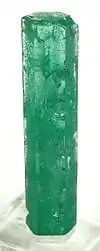Emerald
Emerald is a gemstone and a variety of the mineral beryl (Be3Al2(SiO3)6) colored green by trace amounts of chromium and/or sometimes vanadium.[2] Beryl has a hardness of 7.5–8 on the Mohs scale.[2] Most emeralds are highly included,[3] so their toughness (resistance to breakage) is classified as generally poor. Emerald is a cyclosilicate.
| Emerald | |
|---|---|
_2.jpg.webp) | |
| General | |
| Category | Beryl variety |
| Formula (repeating unit) | Be3Al2(SiO3)6 |
| Crystal system | Hexagonal (6/m 2/m 2/m) Space group: P6/mсc |
| Space group | (6/m 2/m 2/m) – dihexagonal dipyramidal |
| Unit cell | a = 9.21 Å, c = 9.19 Å; Z = 2 |
| Identification | |
| Formula mass | 537.50 |
| Color | Bluish green to green |
| Crystal habit | Massive to well Crystalline |
| Cleavage | Imperfect on the [0001] |
| Fracture | Conchoidal |
| Mohs scale hardness | 7.5–8 |
| Luster | Vitreous |
| Streak | White |
| Diaphaneity | Transparent to opaque |
| Specific gravity | Average 2.76 |
| Optical properties | Uniaxial (−) |
| Refractive index | nω = 1.564–1.595, nε = 1.568–1.602 |
| Birefringence | δ = 0.0040–0.0070 |
| Ultraviolet fluorescence | None (some fracture-filling materials used to improve emerald's clarity do fluoresce, but the stone itself does not) |
| References | [1] |
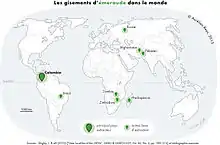
Etymology
The word "emerald" is derived (via Old French: esmeraude and Middle English: emeraude), from Vulgar Latin: esmaralda/esmaraldus, a variant of Latin smaragdus, which was a via Ancient Greek: σμάραγδος (smaragdos; "green gem") from a Semitic language.[4]
Properties determining value
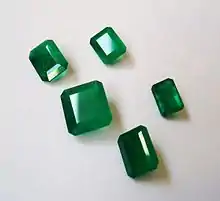
Emeralds, like all colored gemstones, are graded using four basic parameters–the four Cs of connoisseurship: color, clarity, cut and carat weight. Normally, in the grading of colored gemstones, color is by far the most important criterion. However, in the grading of emeralds, clarity is considered a close second. A fine emerald must possess not only a pure verdant green hue as described below, but also a high degree of transparency to be considered a top gemstone.[5]
In the 1960s, the American jewelry industry changed the definition of emerald to include the green vanadium-bearing beryl. As a result, vanadium emeralds purchased as emeralds in the United States are not recognized as such in the UK and Europe. In America, the distinction between traditional emeralds and the new vanadium kind is often reflected in the use of terms such as "Colombian emerald".[6]
Color
In gemology,[7] color is divided into three components: hue, saturation, and tone. Emeralds occur in hues ranging from yellow-green to blue-green, with the primary hue necessarily being green. Yellow and blue are the normal secondary hues found in emeralds. Only gems that are medium to dark in tone are considered emeralds; light-toned gems are known instead by the species name green beryl. The finest emeralds are approximately 75% tone on a scale where 0% tone is colorless and 100% is opaque black. In addition, a fine emerald will be saturated and have a hue that is bright (vivid). Gray is the normal saturation modifier or mask found in emeralds; a grayish-green hue is a dull-green hue.[5]
Clarity
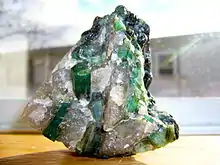
Emeralds tend to have numerous inclusions and surface-breaking fissures. Unlike diamonds, where the loupe standard, i.e. 10× magnification, is used to grade clarity, emeralds are graded by eye. Thus, if an emerald has no visible inclusions to the eye (assuming normal visual acuity) it is considered flawless. Stones that lack surface breaking fissures are extremely rare and therefore almost all emeralds are treated ("oiled", see below) to enhance the apparent clarity. The inclusions and fissures within an emerald are sometimes described as jardin (French for garden), because of their mossy appearance.[9] Imperfections are unique for each emerald and can be used to identify a particular stone. Eye-clean stones of a vivid primary green hue (as described above), with no more than 15% of any secondary hue or combination (either blue or yellow) of a medium-dark tone, command the highest prices.[5] The relative non-uniformity motivates the cutting of emeralds in cabochon form, rather than faceted shapes. Faceted emeralds are most commonly given an oval cut, or the signature emerald cut, a rectangular cut with facets around the top edge.
Treatments
Most emeralds are oiled as part of the post-lapidary process, in order to fill in surface-reaching cracks so that clarity and stability are improved. Cedar oil, having a similar refractive index, is often used in this widely adopted practice. Other liquids, including synthetic oils and polymers with refractive indexes close to that of emeralds, such as Opticon, are also used. These treatments are typically applied in a vacuum chamber under mild heat, to open the pores of the stone and allow the fracture-filling agent to be absorbed more effectively.[10] The U.S. Federal Trade Commission requires the disclosure of this treatment when an oil treated emerald is sold.[11] The use of oil is traditional and largely accepted by the gem trade, although oil treated emeralds are worth much less than un-treated emeralds of similar quality. Other treatments, for example the use of green-tinted oil, are not acceptable in the trade.[12] Gems are graded on a four-step scale; none, minor, moderate and highly enhanced. These categories reflect levels of enhancement, not clarity. A gem graded none on the enhancement scale may still exhibit visible inclusions. Laboratories apply these criteria differently. Some gemologists consider the mere presence of oil or polymers to constitute enhancement. Others may ignore traces of oil if the presence of the material does not improve the look of the gemstone.[13]
Emerald mines
.jpg.webp)
Emeralds in antiquity were mined in Egypt at locations on Mount Smaragdus since 1500 BCE, and India, and Austria since at least the 14th century CE.[14] The Egyptian mines were exploited on an industrial scale by the Roman and Byzantine Empires, and later by Islamic conquerors. Mining ceased with the discovery of the Colombian deposits; only ruins remain.[15]
Colombia is by far the world's largest producer of emeralds, constituting 50–95% of the world production, with the number depending on the year, source and grade.[16][17][18][19] Emerald production in Colombia has increased drastically in the last decade, increasing by 78% from 2000 to 2010.[20] The three main emerald mining areas in Colombia are Muzo, Coscuez, and Chivor.[21] Rare "trapiche" emeralds are found in Colombia, distinguished by ray-like spokes of dark impurities.
Zambia is the world's second biggest producer, with its Kafubu River area deposits (Kagem Mines) about 45 km (28 mi) southwest of Kitwe responsible for 20% of the world's production of gem-quality stones in 2004.[22] In the first half of 2011, the Kagem Mines produced 3.74 tons of emeralds.
Emeralds are found all over the world in countries such as Afghanistan, Australia, Austria, Brazil,[23] Bulgaria, Cambodia, Canada, China, Egypt, Ethiopia, France, Germany, India, Italy, Kazakhstan, Madagascar, Mozambique, Namibia, Nigeria, Norway, Pakistan, Russia, Somalia, South Africa, Spain, Switzerland, Tanzania, the United States, Zambia, and Zimbabwe.[1] In the US, emeralds have been found in Connecticut, Montana, Nevada, North Carolina, and South Carolina.[1] In Canada, in 1997 emeralds were discovered in the Yukon.[24]
Origin determinations
Since the onset of concerns regarding diamond origins, research has been conducted to determine if the mining location could be determined for an emerald already in circulation. Traditional research used qualitative guidelines such as an emerald's color, style and quality of cutting, type of fracture filling, and the anthropological origins of the artifacts bearing the mineral to determine the emerald's mine location. More recent studies using energy dispersive X-ray spectroscopy methods have uncovered trace chemical element differences between emeralds, including ones mined in close proximity to one another. American gemologist David Cronin and his colleagues have extensively examined the chemical signatures of emeralds resulting from fluid dynamics and subtle precipitation mechanisms, and their research demonstrated the chemical homogeneity of emeralds from the same mining location and the statistical differences that exist between emeralds from different mining locations, including those between the three locations: Muzo, Coscuez, and Chivor, in Colombia, South America.[25]
Synthetic emerald
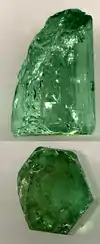
Both hydrothermal and flux-growth synthetics have been produced, and a method has been developed for producing an emerald overgrowth on colorless beryl. The first commercially successful emerald synthesis process was that of Carroll Chatham, likely involving a lithium vanadate flux process, as Chatham's emeralds do not have any water and contain traces of vanadate, molybdenum and vanadium.[26] The other large producer of flux emeralds was Pierre Gilson Sr., whose products have been on the market since 1964. Gilson's emeralds are usually grown on natural colorless beryl seeds, which are coated on both sides. Growth occurs at the rate of 1 mm per month, a typical seven-month growth run produces emerald crystals 7 mm thick.[27]
Hydrothermal synthetic emeralds have been attributed to IG Farben, Nacken, Tairus, and others, but the first satisfactory commercial product was that of Johann Lechleitner of Innsbruck, Austria, which appeared on the market in the 1960s. These stones were initially sold under the names "Emerita" and "Symeralds", and they were grown as a thin layer of emerald on top of natural colorless beryl stones. Later, from 1965 to 1970, the Linde Division of Union Carbide produced completely synthetic emeralds by hydrothermal synthesis. According to their patents (attributable to E.M. Flanigen),[28] acidic conditions are essential to prevent the chromium (which is used as the colorant) from precipitating. Also, it is important that the silicon-containing nutrient be kept away from the other ingredients to prevent nucleation and confine growth to the seed crystals. Growth occurs by a diffusion-reaction process, assisted by convection. The largest producer of hydrothermal emeralds today is Tairus, which has succeeded in synthesizing emeralds with chemical composition similar to emeralds in alkaline deposits in Colombia, and whose products are thus known as “Colombian created emeralds” or “Tairus created emeralds”.[29] Luminescence in ultraviolet light is considered a supplementary test when making a natural versus synthetic determination, as many, but not all, natural emeralds are inert to ultraviolet light. Many synthetics are also UV inert.[30]

Synthetic emeralds are often referred to as "created", as their chemical and gemological composition is the same as their natural counterparts. The U.S. Federal Trade Commission (FTC) has very strict regulations as to what can and what cannot be called a "synthetic" stone. The FTC says: "§ 23.23(c) It is unfair or deceptive to use the word "laboratory-grown", "laboratory-created", "[manufacturer name]-created", or "synthetic" with the name of any natural stone to describe any industry product unless such industry product has essentially the same optical, physical, and chemical properties as the stone named."[11]
In culture and lore
Emerald is regarded as the traditional birthstone for May as well as the traditional gemstone for the astrological sign of Cancer.[31]
One of the quainter anecdotes about emeralds was told by the 16th-century historian Brantôme, who referred to the many impressive emeralds the Spanish under Cortez had brought back to Europe from Latin America. On one of Cortez's most notable emeralds he had the text engraved, Inter Natos Mulierum non sur-rexit mayor ("Among those born of woman there hath not arisen a greater," Matthew 11:11) which referred to John the Baptist. Brantôme considered engraving such a beautiful and simple product of nature sacrilegious and considered this act the cause for Cortez's loss of an extremely precious pearl (to which he dedicated a work, A beautiful and incomparable pearl), and even for the death of King Charles IX of France, who died soon afterward.[32]
The chief deity of one of India's most famous temples, the Meenakshi Amman Temple in Madurai, is the goddess Meenakshi, whose idol is traditionally thought to be made of emerald.[33]
Notable emeralds
| Emerald | Origin | Size | Location |
|---|---|---|---|
| Bahia Emerald[34] | Brazil, 2001 | 180,000 carats, crystals in host rock | Los Angeles County Sheriff's Department[35] |
| Carolina Emperor[36][37] | United States, 2009 | 310 carats uncut, 64.8 carats cut | North Carolina Museum of Natural Sciences, Raleigh |
| Chalk Emerald | Colombia | 38.40 carats cut, then recut to 37.82 carats | National Museum of Natural History, Washington |
| Duke of Devonshire Emerald | Colombia, before 1831 | 1,383.93 carats uncut | Natural History Museum, London |
| Emerald of Saint Louis[38] | Austria, probably Habachtal | 51.60 carats cut | National Museum of Natural History, Paris |
| Gachalá Emerald[39] | Colombia, 1967 | 858 carats uncut | National Museum of Natural History, Washington |
| Mogul Mughal Emerald | Colombia, 1107 A.H. (1695–1696 AD) | 217.80 carats cut | Museum of Islamic Art, Doha, Qatar |
| Rockefeller Emerald [40] | Colombia | 18.04 carats Octagonal step-cut | Private collection |
| Patricia Emerald[41] | Colombia, 1920 | 632 carats uncut, dihexagonal (12 sided) | American Museum of Natural History, New York |
| Mim Emerald[42] | Colombia, 2014 | 1,390 carats uncut, dihexagonal (12 sided) | Mim Museum, Beirut |
Gallery
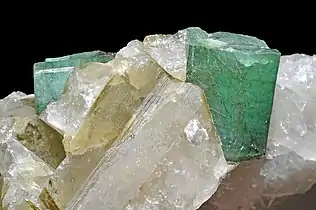 Emerald on quartz, from Carnaiba Mine, Pindobaçu, Campo Formoso ultramafic complex, Bahia, Brazil
Emerald on quartz, from Carnaiba Mine, Pindobaçu, Campo Formoso ultramafic complex, Bahia, Brazil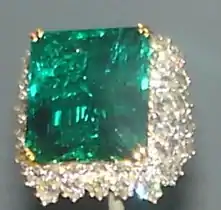 The Chalk Emerald ring, containing a top-quality 37-carat emerald, in the U.S. National Museum of Natural History
The Chalk Emerald ring, containing a top-quality 37-carat emerald, in the U.S. National Museum of Natural History Emerald crystals
Emerald crystals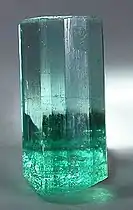 A 5-carat emerald from Muzo with hexagonal cross-section
A 5-carat emerald from Muzo with hexagonal cross-section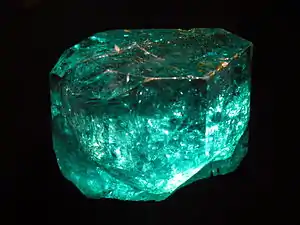 Gachalá Emerald, one of the largest gem emeralds in the world, at 858 carats (171.6 g). Found in 1967 at La Vega de San Juan mine in Gachalá, Colombia. Housed at the National Museum of Natural History in Washington, D.C.
Gachalá Emerald, one of the largest gem emeralds in the world, at 858 carats (171.6 g). Found in 1967 at La Vega de San Juan mine in Gachalá, Colombia. Housed at the National Museum of Natural History in Washington, D.C._-2.jpg.webp)
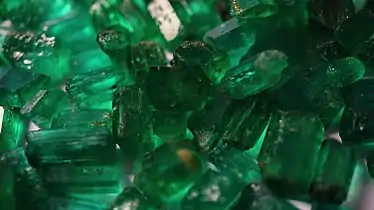 Rough emerald crystals from Panjshir Valley Afghanistan
Rough emerald crystals from Panjshir Valley Afghanistan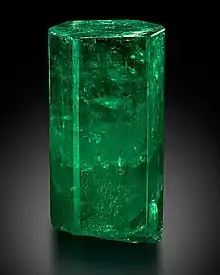 Large, di-hexagonal prismatic crystal of 1,390 carats uncut with a deep green color. It is transparent and features few inclusions in the upper 2/3, and is translucent in the lower part. Housed at the Mim Museum, Beirut, Lebanon.
Large, di-hexagonal prismatic crystal of 1,390 carats uncut with a deep green color. It is transparent and features few inclusions in the upper 2/3, and is translucent in the lower part. Housed at the Mim Museum, Beirut, Lebanon.
References
- "Emerald at Mindat". Mindat.org. July 19, 2010. Archived from the original on July 12, 2010. Retrieved July 30, 2010.
- Hurlbut, Cornelius S. Jr. and Kammerling, Robert C. (1991) Gemology, John Wiley & Sons, New York, p. 203, ISBN 0-471-52667-3.
- "Emerald Quality Factors". GIA.edu. Gemological Institute of America. Archived from the original on November 2, 2016. Retrieved November 1, 2016.
- Harper, Douglas. "emerald". Online Etymology Dictionary.
- Wise, R. W. (2001) Secrets of the Gem Trade: the connoisseur's guide to precious gemstones. Brunswick House Press, p. 108, ISBN 0-9728223-8-0.
- Read, Peter (2008) Gemmology, 3rd rev. ed., NAG Press, p. 218, ISBN 0719803616.
- Grading Fancy-Color Diamonds Archived November 2, 2014, at the Wayback Machine. Gemological Institute of America
- Bonewitz, R. (2005). Rock and gem. New York: DK Pub. pp. 292–293. ISBN 0756633427.
- Emerald Quality Factors Archived February 23, 2014, at the Wayback Machine. Gemological Institute of America.
- Liccini, Mark. Understanding Emerald Enhancements and Treatments Archived December 21, 2014, at the Wayback Machine. International Gem Society
- "Guides for the Jewelry, Precious Metals, and Pewter Industries". U.S. Federal Trade Commission. May 30, 1996. Archived from the original on September 7, 2008. Retrieved July 30, 2010.
- Read, P. G. (October 22, 2013). Gemmology. Elsevier. p. 180. ISBN 9781483144672. Archived from the original on March 31, 2017. Retrieved March 30, 2017.
- Matlins, Antoinette Leonard; Bonanno, Antonio C. (2009). Jewelry & Gems, the Buying Guide: How to Buy Diamonds, Pearls, Colored Gemstones, Gold & Jewelry with Confidence and Knowledge. Gemstone Press. p. 126. ISBN 9780943763712. Archived from the original on March 30, 2017. Retrieved March 30, 2017.
- Giuliani G, Chaussidon M, Schubnel HJ, Piat DH, Rollion-Bard C, France-Lanord C, Giard D, de Narvaez D, Rondeau B (2000). "Oxygen Isotopes and Emerald Trade Routes Since Antiquity" (PDF). Science. 287 (5453): 631–3. Bibcode:2000Sci...287..631G. doi:10.1126/science.287.5453.631. PMID 10649992. Archived (PDF) from the original on August 7, 2011.
- "Romans organized the mines as a multinational business..." Finlay, Victoria. Jewels: A Secret History (Kindle Location 3098). Random House Publishing Group. Kindle Edition.
- Badawy, Manuela (June 13, 2012). "Emeralds seek the 'De Beers' treatment". Reuters. Archived from the original on August 5, 2012. Retrieved June 14, 2012.
- Dydyński, Krzysztof (2003). Colombia. Lonely Planet. p. 21. ISBN 0-86442-674-7.
- Branquet, Y. Laumenier, B. Cheilletz, A. & Giuliani, G. (1999). "Emeralds in the Eastern Cordillera of Colombia. Two tectonic settings for one mineralization". Geology. 27 (7): 597–600. Bibcode:1999Geo....27..597B. doi:10.1130/0091-7613(1999)027<0597:EITECO>2.3.CO;2. S2CID 55974313.CS1 maint: multiple names: authors list (link)
- Carrillo, V. (2001). Compilación y análisis de la información geológica referente a la explotación esmeraldífera en Colombia. Informe de contrato 124. INGEOMINAS
- Wacaster, Susan (March 2012). "2010 Minerals Yearbook: Colombia [ADVANCE RELEASE]" (PDF). United States Geological Survey. Archived (PDF) from the original on August 13, 2012. Retrieved August 7, 2012.
- Emerald Mining Areas in Colombia Archived September 29, 2010, at the Wayback Machine, with location map of these three districts.
- Behling, Steve and Wilson, Wendell E. (January 1, 2010) "The Kagem emerald mine: Kafubu Area, Zambia", The Mineralogical Record – via HighBeam (subscription required) Archived May 10, 2013, at the Wayback Machine
- "Maior esmeralda do mundo, encontrada no Brasil, será leiloada no Canadá Archived April 7, 2014, at the Wayback Machine". UOL (2012-01-18)
- Emeralds in the Yukon Territory Archived March 31, 2014, at the Wayback Machine. Yukon Geological Survey.
- Cronin, David; Rendle, Andy (2012). "Determining the geographical origins of natural emeralds through nondestructive chemical fingerprinting". Journal of Gemmology. 33: 1–13. doi:10.15506/JoG.2012.33.1.1. Archived from the original on November 17, 2015.
- O'Donoghue, Michael (1988). Gemstones. Dordrecht: Springer Netherlands. p. 310. ISBN 9789400911918. Archived from the original on March 30, 2017.
- Nassau, K. (1980) Gems Made By Man, Gemological Institute of America, ISBN 0-87311-016-1.
- Geological Magazine "Hydrothermal process for growing crystals having the structure of beryl in an alkaline halide medium" U.S. Patent 3,567,642 Issue date: March 2, 1971
- Schmetzer, Karl; Schwartz, Dietmar; Bernhardt, Heinz-Jurgen; Tobias Hager (2006–2007). "A new type of Tairus hydrothermally-grown synthetic emerald, colored by vanadium and copper" (PDF). Journal of Gemmology of Gemmological Association of Great Britain. 30 (1–2): 59–74. Archived from the original (PDF) on July 11, 2011.
- Hurlbut, Cornelius S. Jr. and Kammerling, Robert C. (1991) Gemology, John Wiley & Sons, New York, p. 81, ISBN 0-471-52667-3.
- Morgan, Diane (2007). From Satan's crown to the holy grail : emeralds in myth, magic, and history. Westport, Conn. [u.a.]: Praeger. p. 171. ISBN 9780275991234. Archived from the original on March 30, 2017. Retrieved March 30, 2017.
- Kunz, George Frederick (1915). Magic of Jewels and Charms. Philadelphia: Lippincott Company. p. 305. ISBN 0-7661-4322-8. Archived from the original on October 17, 2012.
- "Meenakshi Temple - Meenakshi Temple of Madurai, Meenakshi Amman Temple Madurai India". www.madurai.org.uk. Archived from the original on March 17, 2016. Retrieved January 18, 2016.
- Allen, Nick (September 24, 2010). "Judge to decide who owns 250 million Bahia emerald.html". The Daily Telegraph, UK. Archived from the original on September 28, 2010. Retrieved December 31, 2010.
- "The Curse of the Bahia Emerald, a Giant Green Rock That Ruins Lives". wired.com.
- Gast, Phil (September 1, 2010). "North Carolina emerald: Big, green and very rare". CNN. Cable News Network (Turner Broadcasting System, Inc.). Archived from the original on September 25, 2013. Retrieved October 8, 2013.
- Stancill, Jane (March 16, 2012). "N.C. gems to shine at museum". The News & Observer. The News & Observer Publishing Co. Archived from the original on March 27, 2012. Retrieved October 8, 2013.
- "Emeraude de Saint Louis - St Louis Emerald". CRPG: Le Centre de Recherches Pétrographiques et Géochimiques. Archived from the original on March 4, 2016. Retrieved February 8, 2017.
- "Gachala Emerald". National Museum of Natural History. Smithsonian Institution. 2017. Archived from the original on February 11, 2017. Retrieved February 8, 2017.
- "10 jewels that made history". Christies.
- "Patricia Emerald". AMNH. Archived from the original on September 5, 2015. Retrieved August 22, 2015.
- Bouillard, J.-C. and Jeanne-Michaud, A. (2016) "101 minéraux et pierres précieuses - qu'il faut avoir vus dans sa vie". Hors collection, Dunod. ISBN 2100742272.
Further reading
- Ali, Saleem H. (2006). The Emerald City: Emerald mining in Brazil (+Gemstone mining in other countries) https://web.archive.org/web/20071014012610/http://www.uvm.edu/envnr/gemecology/brazil.html
- Cooper, J. C. (ed.) (1992). Brewer's Myth and Legend. New York: Cassell Publishers Ltd. ISBN 0-304-34084-7.
- Hurlbut, Cornelius S.; Klein, Cornelis (1985). Manual of Mineralogy (20th ed.). New York: John Wiley and Sons. ISBN 0-471-80580-7.
- Sinkankas, John (1994). Emerald & Other Beryls. Prescott, Ariz.: Geoscience Press. ISBN 0-8019-7114-4.
- Tavernier, Jean-Baptiste (1925 [1676]). Travels in India (second edition), Volume II. Edited by William Crooke and translated by V. Ball. London: Oxford University Press.
- Weinstein, Michael (1958). The World of Jewel Stones. New York: Sheriden House. OCLC 519758.
- Wise, Richard W. (2003). Secrets of the Gem Trade: The Connoisseur's Guide to Precious Gemstones. Lenox, Mass.: Brunswick House Press. ISBN 9780972822398. OCLC 55662640. Online Emerald chapters.
External links
| Wikimedia Commons has media related to Emeralds. |
- ICA's Emerald Page International Colored Gemstone Association Emerald Page
